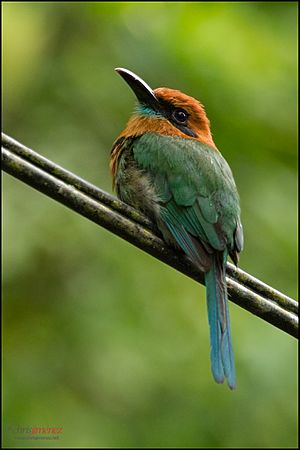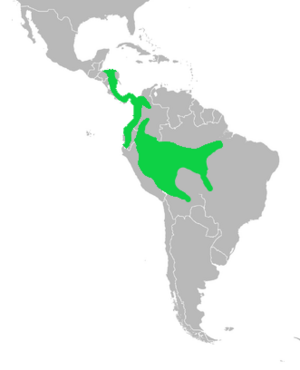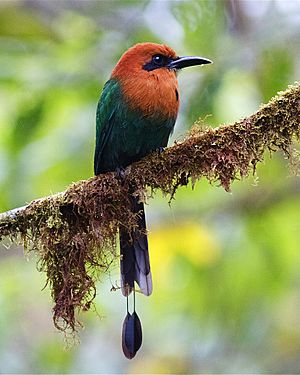Broad-billed motmot facts for kids
Quick facts for kids Broad-billed motmot |
|
|---|---|
 |
|
| Conservation status | |
| Scientific classification | |
| Genus: |
Electron
|
| Species: |
platyrhynchum
|
 |
|
The broad-billed motmot (Electron platyrhynchum) is a colorful bird found in Central and South America. It belongs to the Momotidae family. These birds do not migrate, meaning they stay in the same area all year. You usually see them alone or in pairs. There are six different types, or subspecies, of the broad-billed motmot.
Contents
What Does It Look Like?
The broad-billed motmot is one of the smaller birds in the Momotidae family, growing to about 12 inches long. They weigh around 60 grams, which is about the same as a small apple. They have dark eyes and feet.
Most of their upper body, including their head, neck, and chest, is a reddish-brown color. They have a black patch on each side of their head, covering their cheeks. There's also a black spot in the middle of their chest. The lower part of their body is more greenish, turning blue closer to their belly.
This bird has a long tail that changes from blue to black. Two of its central tail feathers are much longer than the others and look like tiny tennis racquets! As its name suggests, the broad-billed motmot has a wide, flat bill. Its bill is black with jagged edges, like a saw. Both male and female broad-billed motmots look exactly alike. This is called not having sexual dimorphism.
Young broad-billed motmots are a bit duller and darker than the adults. They also have some white on their bill and a blue-green stripe above their eye.
The broad-billed motmot looks very similar to the rufous motmot. However, the broad-billed motmot is smaller and has a bigger black patch on its head. It also has a blue-green chin.
Bird Family Tree
The broad-billed motmot is part of the Momotidae family. This family belongs to a larger group of birds called the Coraciiformes order. This order also includes kingfishers and bee-eaters.
There are six different types, or subspecies, of the broad-billed motmot. Three of these subspecies are special because they don't have the racquet-shaped tail feathers. Because of this, some scientists think they might be a separate species called "plain-tailed motmots."
Where Do They Live?
These birds live in a wide area. You can find them in the eastern part of Central America, from Honduras to Panama. Their home also stretches into many countries in north-western South America, like Colombia, Ecuador, Peru, Bolivia, and Brazil.
Broad-billed motmots prefer to live in humid forests, warm lowlands, and hilly areas. They are usually found at elevations below 3,000 feet (about 914 meters).
How They Behave
Bird Calls and Songs
The motmot family may be small, but they make many different sounds. The broad-billed motmot's main sound is its song, which they often sing at sunrise. It sounds like a nasal "cwaah" and is usually repeated slowly. Sometimes, they sing it faster or even as a duet with another bird. Their call, which is heard less often, is a quiet string of "tuk" sounds that can sometimes turn into a rattling noise.
What Do They Eat?
The broad-billed motmot mainly eats insects. Their diet includes many different insects and their young (larvae). They also eat spiders, centipedes, and scorpions. Sometimes, they will even eat small animals like snakes, frogs, and lizards. When there are many cicadas around, these birds will mostly eat them. Unlike some other motmots, broad-billed motmots do not eat fruit.
These birds hunt in a smart, energy-saving way. They sit and watch their surroundings until they spot something interesting to eat. Then, they quickly fly out to grab their prey, a method called a "sally-strike." After catching their meal, they fly back to their perch to eat it.
Reproduction and Life Cycle
In Costa Rica, broad-billed motmots lay their eggs between February and May. They usually lay 2 or 3 eggs at a time. These birds are socially monogamous, meaning a male and female pair up to raise their young. They build their nests in burrows dug into earth banks. Both parents take turns sitting on the eggs to keep them warm (this is called incubating), though the female often spends more time doing this. We don't know exactly how long the eggs take to hatch. When the chicks hatch, they are naked and cannot see. Both parents share the job of feeding their young.
How Are They Doing?
The broad-billed motmot is currently considered a species of least concern by the IUCN Red List (from 2016). This means they are not in immediate danger of disappearing. They are common in the areas where they live. However, their populations are being negatively affected by deforestation, which is when forests are cut down.
See also
 In Spanish: Momoto picoancho para niños
In Spanish: Momoto picoancho para niños



